This article includes a list of general references, but it lacks sufficient corresponding inline citations .(January 2013) |
This article provides an overview of the transport infrastructure of Latvia.
This article includes a list of general references, but it lacks sufficient corresponding inline citations .(January 2013) |
This article provides an overview of the transport infrastructure of Latvia.

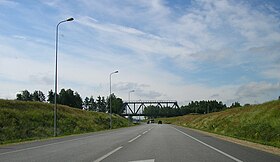
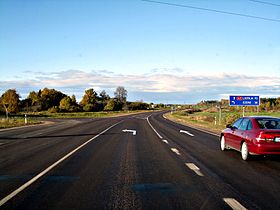
It is mandatory to keep headlights on while driving, even in daylight; most cars commercially sold in Latvia are equipped to make this automatic.
| Number | E-road | Route | Length (km) |
|---|---|---|---|
| | Rīga - Ainaži (EE border) | 101 | |
| | Rīga - Sigulda - Veclaicene (EE border) | 196 | |
| | Inčukalns - Valmiera - Valka (EE border) | 101 | |
| | Rīga ring road (Baltezers - Saulkalne) | 20 | |
| | Rīga ring road (Salaspils - Babīte) | 40 | |
| | Rīga - Daugavpils - Krāslava - Pāternieki (BY border) | 307 | |
| | Rīga - Bauska - Grenctāle (LT border) | 85 | |
| | Rīga - Jelgava - Meitene (LT border) | 76 | |
| | Rīga - Skulte - Liepāja | 199 | |
| | Rīga - Ventspils | 190 | |
| | Liepāja - Rucava (LT border) | 57 | |
| | Jēkabpils - Rēzekne - Ludza - Terehova (RU border) | 166 | |
| | Grebņeva (RU border) - Rēzekne - Daugavpils - Medumi (LT border) | 163 | |
| | Daugavpils ring road (Tilti - Kalkūne) | 15 | |
| | Rēzekne ring road | 7 |
| Roads | Paved, km | Unpaved, km | Total, km |
|---|---|---|---|
| State-owned roads | |||
| Highways (A) | 1651.1 | - | 1651.1 |
| Regional roads (P) | 4189.9 | 1127.5 | 5317.4 |
| Local roads (V) | 2616.7 | 10533.4 | 13150.1 |
| Municipality-owned roads | |||
| Roads | 1055.6 | 29593.5 | 30649.1 |
| Streets | 4588.2 | 3446.4 | 8034.6 |
| Other roads | |||
| Forest roads | - | 10142 | 10142 |
| Private house roads | 500 | 3000 | 3500 |
| Total | 14601.5 | 57842.8 | 72444.3 |
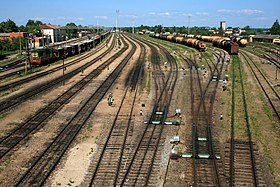

Latvian Railways is the main state-owned railway company in Latvia. Its daughter companies both carry out passengers services as well as carry a large quantity of freight cargo, and freight trains operate over the whole current passenger network, and a number of lines currently closed to passenger services.
There is also a narrow gauge railway between Gulbene and Aluksne, operated by the Industrial Heritage Trust, using Russian and Polish built heritage rolling stock. Three narrow gauge trains a day operate on the 33 km route between the two towns.
total: 2,347 km
Russian gauge: 2,314 km 1,520 mm (4 ft 11+27⁄32 in) gauge (270 km electrified)
narrow gauge: 33 km 750 mm (2 ft 5+1⁄2 in) gauge (2002)
Vivi is the only passenger-carrying operator in Latvia.
Domestic passenger lines with current service are:

Riga International Airport is the only major airport in Latvia, carrying around 5 million passengers annually. It is the largest airport in the Baltic states and has direct flights to over 80 destinations in 30 countries. It is also the main hub of airBaltic.
In the recent years airBaltic also operated from Liepāja International Airport as well as Ventspils International Airport but operations in both of these airports were ceased until 2017, when airBaltic relaunched flights from Riga to Liepaja.
Currently there are plans for further development in several regional airports, including Jūrmala Airport, Liepāja, Ventspils as well as Daugavpils International Airport.
As of 2003, there were a total of 51 airfields in Latvia, with 27 of them having paved runways.
Airports - with paved runwaystotal: 27
2,438 to 3,047 m: 7
1,524 to 2,437 m: 2
914 to 1,523 m: 2
under 914 m: 16 (2003)
Airports - with unpaved runwaystotal: 24
2,438 to 3,047 m: 1
1,523 to 2,438 m: 2
914 to 1,523 m: 1
under 914 m: 20 (2003)


Key ports are located in Riga (Freeport of Riga and Riga Passenger Terminal), Ventspils (Free port of Ventspils), and Liepāja (Port of Liepāja). Most transit traffic uses these and half the cargo is crude oil and oil products. [1]
300 km (perennially navigable)
crude oil 412 km; refined products 421 km; natural gas 1,097 km (2003)
total: 11 ships (with a volume of 1,000 gross tonnage (GT) or over) totaling 53,153 GT/37,414 tonnes deadweight (DWT)
note: includes some foreign-owned ships registered here as a flag of convenience: Germany 1, Greece 1, Ukraine 1 (2002 est.)
ships by type: cargo ship 6, petroleum tanker 1, refrigerated cargo 2, roll-on/roll-off ship 1, short-sea/passenger 1
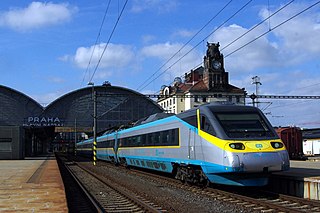
Transport in the Czech Republic relies on several main modes, including transport by road, rail, water and air.
Transportation in Ecuador is the transport infrastructure networks in Ecuador and those connecting the country with other countries. Transportation in Ecuador include aviation, highways, pipelines, ports and harbors, railways and waterways. Apart from transporting passengers, the country is a relatively small exporter of fruits and vegetables such as banana, papayas and pineapples.

Transport in Ethiopia is overseen by the Ministry of Transport and Communications. Over the last years, the Ethiopian federal authorities have significantly increased funding for rail and road construction to build an infrastructure, that allows better economic development.
Railways: 0 km
For Soviet transportation, see Transport in the Soviet Union.

Transport in Greece has undergone significant changes in the past two decades, vastly modernizing the country's infrastructure and transportation. Although ferry transport between islands remains the prominent method of transport between the nation's islands, improvements to the road infrastructure, rail, urban transport, and airports have all led to a vast improvement in transportation. These upgrades have played a key role in supporting Greece's economy, which in the past decade has come to rely heavily on the construction industry.
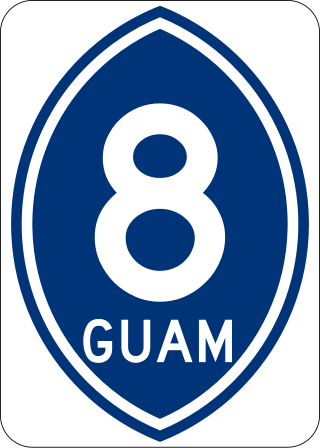
The United States territory of Guam has no railways or freeways, nor does it have a merchant marine. The largest port is Apra Harbor, which serves almost all commercial traffic including cruise, cargo and fishing vessels. There are smaller harbors located on the island which serve recreational boaters. Roads are primarily paved by a coral/oil mixture that, when it gets wet, tends to have oil float to the surface, making the roads dangerous. This is one of the reasons the speed limit on most of the island is 35 mph. But, during road repair or maintenance, a different mixture of asphalt that is not as slippery is used. Its main commercial airport is the Antonio B. Won Pat International Airport.
Transport in Hungary relies on several main modes, including transport by road, rail, air and water.
Transport in Lithuania relies mainly on road and rail networks.

This article describes the transport in Peru.

The transport network of the Russian Federation is one of the world's most extensive transport networks. The national web of roads, railways and airways stretches almost 7,700 km (4,800 mi) from Kaliningrad in the west to the Kamchatka Peninsula in the east, and major cities such as Moscow and Saint Petersburg are served by extensive rapid transit systems.

The Republic of Suriname has a number of forms of transport. Transportation emissions are an increasing part of Suriname's contributions to climate change, as part of the Nationally Determined Contributions for the Paris Agreement, Suriname has committed to emissions controls for vehicles and increased public transit investment.
Transportation in the country of Togo is by road, rail, water or air.

Vanuatu's undeveloped road system, with fewer than 100 miles of paved roads, consists mostly of dirt tracks suitable only for four-wheel-drive vehicles. Every island has one or two short airstrips where Vanair’s Twin Otter planes land two or three times weekly. In addition, every island has a small port or wharf where small cargo ships and boats regularly dock.

The transport in Azerbaijan involves air traffic, waterways and railroads. All transportation services in Azerbaijan except for oil and gas pipelines are regulated by the Ministry of Transportation of Azerbaijan Republic.

Latvijas dzelzceļš is the state-owned company responsible for managing public railway infrastructure in Latvia. It is fully owned by the Latvian government, with 100% of its shares held by the state. The company’s sole shareholder is the Latvian Ministry of Transport. Latvijas dzelzceļš was founded on 2 September 1991 and is considered the successor of the Latvian State Railways company which was established on 5 August 1919 and dissolved by the Soviet occupation of Latvia in 1940.
The 2011 Latvian Higher League was the 20th season of top-tier football in Latvia. It began on 15 April 2011 and ended on 5 November 2011.
The 2016 Latvian Higher League was the 25th season of top-tier football in Latvia. FK Liepāja were the defending champions. The season began on 11 March 2016 and ended on 5 November 2016; the relegation play-offs took place on 9 and 13 November 2016.